well here we are, getting into autumn now, there are already carved pumpkins out on doorsteps in our neck of the woods, so watch out for a spooky Hallowe`en special coming to these parts very soon.
Now you may have noticed that our card of the day is slightly different these days, and a few of you have asked about the new timings. What used to happen is that I added the solution at 8pm and the new "front only" card at midnight. But what happens now is the timings remain the same but the code does not show until the card shifts across at midnight. One suggestion to resolve this is to have a question mark card inserted at 8pm, which would force the current card to appear with the code in the second box. (I hope you are all following this?) However, thinking about it, we could always insert the new "front only" card at 8pm rather than at midnight. This would mean that at 8pm you saw the back and code of the current card, and got the front of the next card. So lets have your thoughts and we will oblige with what the majority thinks best.
So what is coming along this week?
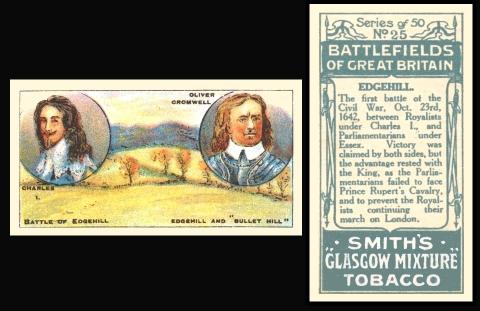
F. & J. Smith [tobacco : UK]”Battlefields of Great Britain” - `Glasgow Mixture` tobacco` brand (December 1913) 25/50 - S548-050.E : S84-2.E
On the 23rd of October 1642, the first major battle of the English Civil War took place at Edge Hill in South Warwickshire.
The most stirring card is, strangely, by American Tobacco, it comes from their "Battle Scenes" and shows "Prince Rupert`s Last Charge at Edgehill"; he was the nephew of the King, but the text ends rather disappointingly by saying that "The battle was undecisive". By the way this picture is actually from an 1887 painting by Stanley Berkeley which ought to be called simply "Prince Rupert at the Battle of Edgehill, 1642" and which appeared in black and white in The Illustrated London News on the 12th of February 1887 - this makes it look like it was snowing, but actually it was just raining and very windy.
This card shows us a rough view of the field, plus miniature portraits of the leaders of both sides, Charles I (who was on the field with Prince Rupert for the Royalists) and Oliver Cromwell (who arrived too late to take part, but whose Parliamentarians were represented by the Earl of Essex, an odd character who had taken his coffin to war with him, just in case).
"Bullet Hill", mentioned on this card, was just a raised area where the heavy guns were sited. The reverse is a really good description for, like on the A.T.C. card, it is generally regarded that this rather chaotic initial skirmish should be considered a draw, but here on this card it actually says the truth, that whilst "Victory was claimed by both sides ... the advantage rested with the King" who was able to continue marching towards London rather than being turned away by a defeat.
You can read the full story of the battlefield at :
https://www.britishbattles.com/english-civil-war/the-battle-of-edgehill/
and there is a really fascinating "spooky" - and true - story at http://www.real-british-ghosts.com/edgehill-ghosts.html
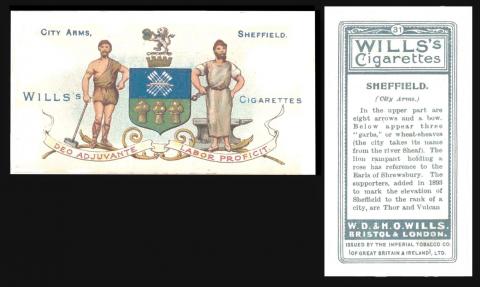
Now there is a neat link here, as in October 1642 Cromwell`s Parliamentary soldiers occupied Sheffield castle.
However, we are more interested in the 24th of October, 1857, when the World's oldest operational association football club was founded. This is said to be "Sheffield Football Club" a fact which is not as straightforward as it might appear, there being more than one Sheffield F.C.. One contender is Sheffield United, "The Blades", but they were definitely founded in 1889. More likely is Sheffield Wednesday F.C., who started to play in the Football Alliance in 1889, but had been playing outside the Alliance for some time. However most club histories say "Founded 1867 (1857)", at which time it was simply called "the Sheffield Club". This appears to have started as "The Wednesday Cricket Club", in 1820, but reportedly once the cricket season was over they kept training to maintain their fitness, and incorporated other exercises, including kicking a ball. Other clubs must have followed this system, and their first "football match" with another club took place in 1857 (Sheffield 2 - Hallam 0).
However some still maintain that Sheffield Wednesday and the Sheffield Club are not the same, and they cite the Sheffield Football Club as being the holder of the "first club" title. These currently play at Dronfield in Derbyshire as part of the Northern Premier League and their website https://sheffieldfc.com/ is emblazoned with them being the first football team, and there is pretty solid proof as part of their archives. However we do not think they appear on a cigarette or trade card, so we have gone for the Arms of Sheffield which encompass all three teams. And we have found you a great link to a couple of pages of wonderful Sheffield football trade and cigarette cards - check out https://www.footballsoccercards.com/sheffield-united-134-c.asp - and https://www.footballsoccercards.com/sheffield-wednesday-97-c.asp

Monday
On the 25th of October 1854, at Balaclava, during the Crimean War, one Lord Lucan led a group of horsemen against the enemy. This action would become known as "The Charge of the Light Brigade". It was almost certainly way more chaotic than it has been recorded in Tennyson’s poem, but the poem certainly ensured the action would endure, and also led to many paintings and other artworks. The Crimean War was just too early for cards to be issued during it, but it is quite popular with card issuers. The first cards to show you are two you might find unusual - these are John Player "History of Naval Dress", which feature two cards of the Naval Brigade, Crimea, 42/50 being an officer and 43/50 being a seaman. If you thought that Crimea was a land battle, well it was, but Crimea was a peninsula, and the easiest access to it was by sea. You can see a map of this, courtesy of Ardath "Modern School Atlas" 62/96, above. Though the war contained many acts of bravery, and over a hundred Victoria Crosses were awarded, including the first of all - see https://www.historytoday.com/archive/first-victoria-cross - it is often spoken of for the calamities and mismanagement that could have been avoided. Florence Nightingale only became involved after reading newspaper reports of the terrible and unsanitary conditions that the wounded men were facing, more of whom were dying of infection, and malnutrition than they were of injuries sustained in the war. https://www.tcdb.com/Person.cfm/pid/69790/col/1/yea/0/Florence-Nightingale?sTeam=&sCardNum=&sNote=&sSetName=&sBrand= will show you a selection of cards of her, but there is at least one earlier, see above, Carreras "Famous Women", issued in 1929, where she is 5/27.
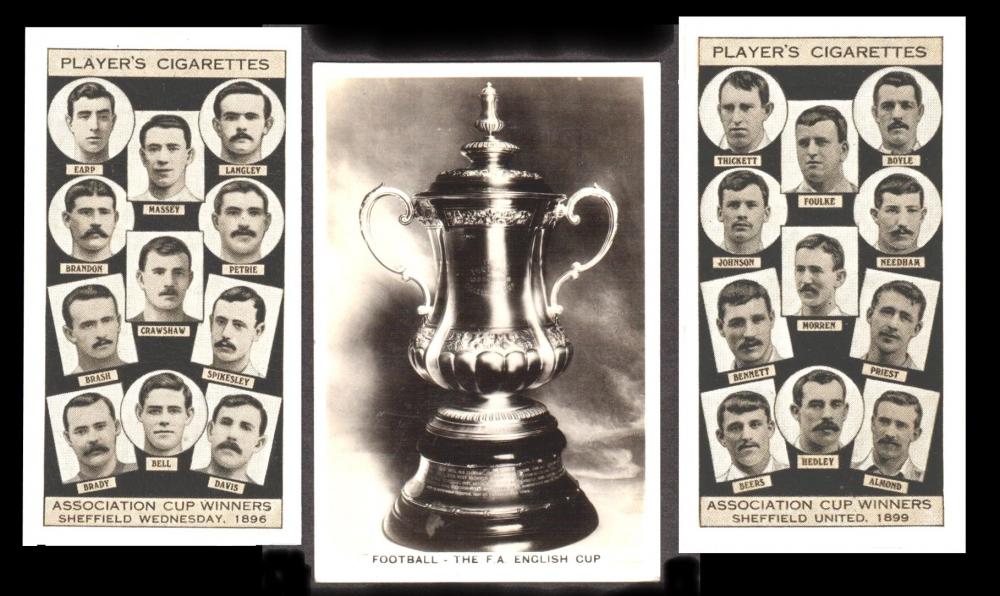
Tuesday
on the 26th of October, 1863, the English Football Association was formed. Now coincidentally, this led directly to a meeting on the 23rd of March, 1888, at The Andertons Hotel, 102-105 Fleet Street in London between chairmen from existing clubs, who decided to form an English Football League. Now fast forward to 15 December 1938 and to the inaugural meeting of a group called The Cartophilic Society, which was also held at Anderton’s Hotel, 102-105 Fleet Street in London. But I digress, as usual. Last week for our "Rugby Special" we featured a set of football cards issued in 1902 by W.D. & H.O. Wills, and many of you asked if this was the earliest set. It is not, but it did form the start of footballing frenzy as sets of football related cards were also issued in that year by J.F. Bell and by F & J Smith. However, as far as I know, the first footballing card set was Marcus & Co., and this was called "Footballers & Club Colours" and it was issued in 1896. Now some reference works say that the next set was issued by Kinnear in 1898, and carries the same title, but this is incorrect, as it was the same set; in fact it was the same cards that had been printed for Marcus, simply stamped with "Kinnear Limited" on the backs! You can read all about this, and see the backs, at https://cartophilic-info-exch.blogspot.com/2014/11/kinnear-co-marcus-football-clubs.html
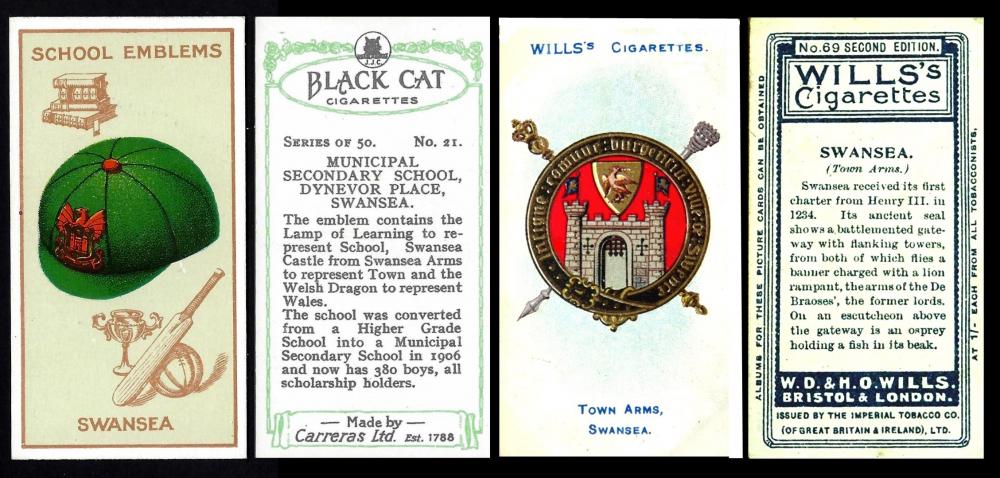
Wednesday
On the 27th of October 1914, the Welsh poet Dylan Marlais Thomas was born in Swansea. First published as a teenager, he went on to write plays and appear in radio broadcasts, as well as to tour America; it was on one of these trips, in New York, that he died, at the age of 39. He was buried at St Martin's churchyard in Laugharne.
Reportedly he used to be repeatedly struck with inspiration whilst out and about and would write notes furiously on anything to hand. He found cigarette packets were most useful, it is written that these were mostly Woodbines. He was frequently pictured smoking, and in fact freely admitted he had smoked as a child; he features the innocence of childhood smoking in "A Child`s Christmas in Wales" a short story, which you can read at http://www.classicshorts.com/stories/xmas.html
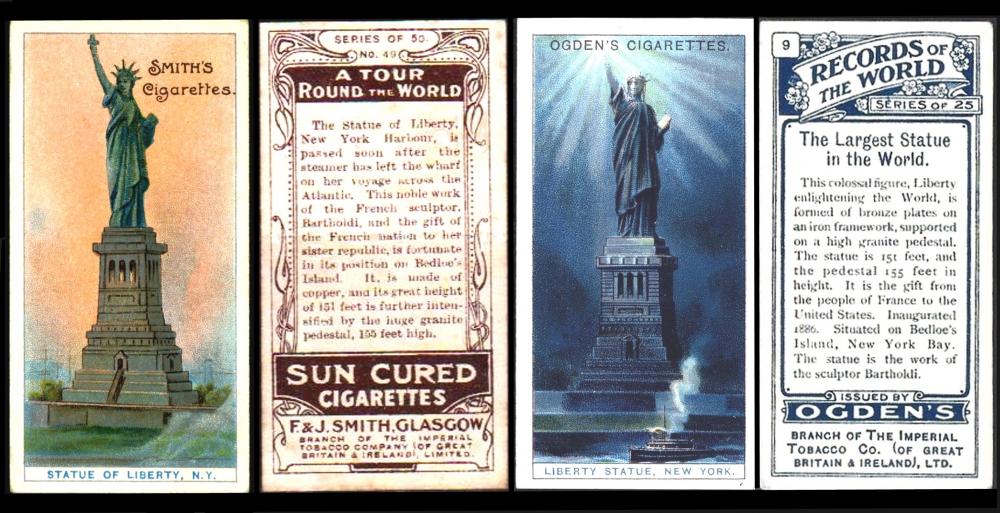
Thursday
On October 28, 1886, the Statue of Liberty was dedicated. It had arrived in New York Harbour and been placed on Bedloe's Island in New York Harbor, a gift from the peoples of France . The 300 foot statue was a gift from the people of France as commemoration of the American Revolutionary War in which the French and Americans fought together. The statue is a very popular image, and stands for America as well as for New York; you see it on all kinds of advertising, and the reason for this is that the sculptor, Frédéric-Auguste Bartholdi (who you can reportedly see on "Rulers, Celebrities, or Baseball series" (N370), issued by Lone Jack) actually licensed the image himself in 1875, almost a decade before it even reached America, and he expressed that it should be made universally available for commercial usage, including trade cards: and here is one which was owned by Jefferson Burdick - https://www.metmuseum.org/art/collection/search/746640
Many more early trade cards are available to view through https://duckduckgo.com/?q=statue+liberty+trade+card&t=brave&iax=images&ia=images
It is also on Beaulah "Marvels of the World" (1954) 2/24 and Liebig S847 "Famous Statues" (1906). As far as cigarette cards, we have not found many, but it is photographed on Bucktrout "Around the World" 166/208, and most attractively on F & J Smith "A Tour Round the World" (1906) 49/50

Friday
On the 29th of October 1932 the French ocean liner Normandie was launched. She did not enter service until 1935, but she was immediately the largest, fastest, passenger ship that you could travel on, setting and holding the record of a four day three hours and two minute Atlantic crossing. And she was also the most luxurious, with no expense spared on her fixtures and fittings. Now 1935 puts her clearly in the "inter-wars" cigarette card heyday, so there is no shortage of cards for us to chat about. What the cards do not tell us, because they were too early, is that her end was a sad one; she was captured by the American authorities during the Second World War and pressed into service as USS Lafayette, a troopship. However she never managed to fulfil that purpose as she caught fire during the conversions and side slipped down into the Hudson River. She was actually salvaged, but restoration was just too costly, and she was scrapped in 1946. Of course, there were conspiracy theories; have a look at https://www.historynet.com/the-fate-of-the-ss-normandie.htm
The most easily found card of her is W.D. & H.O. Wills "Speed" (1938) 38/50 - but others include Godfrey Phillips "Ships that Have Made History" (1938) 35/36, Richard Lloyd "Atlantic Records" (1936) 24/25, R & J Hill "Famous Ships" (1939) 31/50. And there are several cards in Ogden and Hignett "Ocean Greyhounds"(1938)
This week's Cards of the Day...
Saturday, 16th October 2021
![O100-516 [tobacco : UK] Ogden "Famous Rugby Players" (1926-1927) 14/50](/sites/default/files/styles/content_aligned/public/2021-10/16%20pair.jpg?itok=nugPA1W1)
now our cards of the day this week will be celebrating three things, the 150th anniversary of the formation of the Rugby Football Union (RFU), the 150th anniversary of the first international match between England and Scotland in 1871, and the latest set of Royal Mail postage stamps being issued tomorrow (Tuesday 19 October). These feature eight major events in rugby history - the 1970, 1984 and 1994 Five Nations Championships, the 1998 Women’s Home Nations Championship, the 2003 Rugby World Cup Final, the 2009 Women’s Six Nations Championship, the 2014 Women’s Rugby World Cup Final, and the 2015 Six Nations Championship, and include portraits of many notable names. And you can read more at https://blog.norphil.co.uk/2021/10/150th-anniversary-of-rugby-union-set-of.html
Saturday 16 October
O100-516 [tobacco : UK] Ogden "Famous Rugby Players" (1926) 14/50. These black and white cards cover English, Irish, Scottish and Welsh Rugby Union and Rugby League footballers, cards 1 to 23 being Rugby Union, and 24 to 50 being Rugby League. Our man is Thomas R Hewitt and you can read more about him at http://en.espn.co.uk/timeline/rugby/player/3093.html - which includes a link to his younger brother Francis Seymour Hewitt, who was also a rugby player. Card 15 of this set shows another alumni of Queens College in Belfast, G.V. Stephenson. And you can see the College itself on Gallaher "Irish View Scenery" 173/600 - if you dont have a set to hand, just click along to : https://www.archiseek.com/2012/buildings-from-the-irish-views-series-by-gallaher/nggallery/page/2 (where it is third from the end). By the way, before we go any further, http://www.rugbyrelics.com is a great rugby themed shop site with some amazing items.
Sunday, 17th October 2021
![H536-280 [tobacco : UK] Hignett "International Caps and Badges" (May 1924) 8/25](/sites/default/files/styles/content_aligned/public/2021-10/17%20centenary.jpg?itok=ZireVURG)
This card features the Rugby Centenary, but as we will find out this week a lot of sets are of mixed sports and several combine both Rugby and Soccer within the same "Football" set.
As far as this set, sports collectors may not realise that it includes The Lawn Tennis Association, which I will almost certainly forget by the time it is Wimbledon, and even more excitingly the badge (on a hat band) and flag for the Great Britain team who were going to the Olympic Games of 1924, to be held in Paris.
The Rugby Centenary featured on this card records the date of 1823, when William Webb Ellis, of Rugby School, picked up the ball and ran with it. Now an image of the buildings of Rugby School appears on Hills "Views of Interest" fourth series card 173 - on "Sunripe" brand "Public Schools and Colleges" (1923) 35/50 - and on Wills "Public Schools" (1927) 20/25 - all of which mention the introduction of Rugby - whilst its emblem or crest appears on Cavanders "School Badges" (1928) Un/25 - where the text tells us "its great game is rugger" - Wills "Arms of Public Schools" large size 25/25 and Wills "School Arms" (1906) 16/50
Monday, 18th October 2021
![W675-070 [tobacco : UK] W.D. & H.O. Wills "Sports of Countries" (1900) 16/50](/sites/default/files/styles/content_aligned/public/2021-10/18%20sports.jpg?itok=KeP7gpfK)
First of all look at the size of that post it is huge, so did the illustrator not play rugby, take his cue from the text, and think the goal was the same size as a football one? According to some research, the width of a football goal is 24 foot long, whilst that for professional Rugby is 18.71’-19.03’ | 5.7-5.8 m (Overall), whilst the inside width of the crossbar varies depending on whether it is a League match at 18.04’ | 5.5 m - or a Union one at 18.37’ | 5.6 m (Union).
This is a most attractive set, though it does include several "sports" that are thankfully not to popular taste today. However it does include a very sought after card for cricket fans, card 14 which shows "Cricket - Batting (England)" - the batter shown is none other than W.G. Grace.
The set is also vari-backed, and you can see samples of all the backs, including the more recent reprint version, courtesy of our friends at The Cartophilic Info Exchange
Tuesday, 19th October 2021
![M757-360 [tobacco : UK] Stephen Mitchell & Son "Sports" (1907) Un/25](/sites/default/files/styles/content_aligned/public/2021-10/19%20mitchell%20pair.jpg?itok=VnBzddZe)
Stephen Mitchell was actually founded in 1723, in a small cottage in Linlithgow, moving to Glasgow in 1825. They were not just a maker of tobacco, they also sold snuff, tea, sugar, black pepper, cheese and soap. And their factory was taken over for "war work" during the Second World War.
These cards are most attractive, but are unnumbered, the cards were first listed in the London Cigarette Card Company Handbook of 1950, under H.275, a number code they retain in our own World Tobacco Issues Index to this day. However in the 1950 book there is the additional information that the back was illustrated in Cartophilic World, page 679. This page turns out to be in Volume 6, No.69, issued for November 1948, and the article was written by Eric Gurd.
In the 1950 L.C.C.C. Catalogue the cards are listed for sale at 8/6 to 25/- per card, or sets were available at £30.
Wednesday, 20th October 2021

These are very odd items, being more like single cel projector slides, or film transparencies, than cards, and which measure 37 x 34 mm.
There is no set title on these, but the special albums carry the wording "Flixies Album" and from that we named the sets.
Each of the three albums took four sets, being held in by corner slots. In our British Trade Index Part II, issued in 1969, it tells us that the other sets in that album were Dog Series, Aviation Series, and British Bird Series.
Blue Cap was a brand of cheese, and had earlier (1953-1959) issued five sets of what are classed as package issues, being trimmed out from the boxes. Series A, B and C were each twelve cards in the "Farm Series" and they were designed so that the bottom of the circular box was cut off in its entirety to form the "card". However Series D ("Sports Series") and E ("Animal Series") had two small cards printed on which were designed to be cut out separately.
These sets were again twelve cards in length but the "Animal Series" seems to have ended prematurely and in the British Trade Index Part II, it was said that numbers 9 - 12 were not thought to have been issued. However these had been found by 1986, when British Trade Index Part III was issued.
Thursday, 21st October 2021
![W675-114 [tobacco : UK] W. D. & H.O. Wills "Football Series" (1902) 52/66](/sites/default/files/styles/content_aligned/public/2021-10/21%20football.jpg?itok=SUfrvwxR)
This set may be called "Football" but it includes rugby as well, and here is W.J. "Billy" Bancroft, of Swansea. Billy must mean that the "W" was William. You can see a larger photo of him in The People`s Collection Wales/33698 - and, rather thrillingly, his Cadle card is used on his Wikipedia entry.
However the Trading Card Database/BBancroft has him on just three cards, the other one being by J.F. Bell, and that uses exactly the same portrait as on our card.
He was a shoemender and cobbler, with a natural talent for sport, playing both rugby and cricket and, like his father, being one of the best players on the Glamorganshire squad. In fact the two were often seen in the same match. Our man`s cricketing debut came aged just eighteen, in 1889, and in 1895 he was actually the first of their players to turn "professional". His younger brother would also play for the same team, later, starting in 1908.
These cards use different photographers, and this one credits "Thiele London", who was actually a very famous photographer Karl Anton Reinhold Thiele, born in 1856 in Hamelin, in Germany and relocated to England in 1878 after an offer of work from William Henry Prestwich. He was also employed by the London Stereoscopic Company, at first as one of the painters who hand coloured the photos, but then it became known that he was actually a photographer and he started taking the pictures instead. He seems to have specialised in sports photography, and some people consider him the first true sports photographer of all.
This is not his only claim to cartophilic fame, for he also worked on the Ogden`s Guinea Gold series, including the portrait of Ranjitsinhji which is held at the National Portrait Gallery.
The set first appears in our Wills Reference Book part II, as W/22. There is quite a lengthy description too, of :
22. 66 FOOTBALL SERIES
Fronts printed in black, with white border. Series title inset at top with number, player`s name inset at base with photographer`s credit below. Backs in bronze blue : two different advertisements :-"Wills`s Cinderella" Cigarettes (Nos. ending in 1. 4 and 7 from 1-50 and Nos. 51, 53, 57, 60 and 63)
"Wills`s Wild Woodbine" Cigarettes (All other numbers)
There are at least three different kinds of card :
(a) Pure white (coated) both sides
(b) Pure white on fronts, cream buff backs
(c) Pure white on fronts, dull grey backs.There also appears to be a series printed on a card which has a pronounced dirty pink tint. The back colouring varies considerably from bronze blue to a chalky blue shade. Fronts vary in shade from grey-black to black.
Two varieties of card No.18 - "W.J. Foulkes" - exist: (a) head and shoulders portrait (b) three-quarter portrait. Probably two distinct printings could be made up of each which would include one of the above cards. Cards are known with the subject title in (a) small and (b) larger lettering. Although this set is similar to Clarke`s "Footballers" it is not identical. In all cases the club or team is quoted on the Wills but omitted on Clarke`s cards, and there are other minor differences. Issue date : 1902. Printed by E. S. & A. Robinson, Ltd.
We used the "Cinderellas" version as the Card of the Day for the 19th of August, 2023.
So this sets up a few questions for you to answer.
Firstly, the curious nature of the advertisement numbering, as to especially the final run. This rather suggests that it was planned to be a set of fifty cards, or perhaps fifty two - in which case the uniformity of the numbering would have been preserved - but for some reason they added these extra sixteen and let the advertisements fall where-ever.
Finally, whilst we have a year date of 1902, there is no month of issue, unless any Wills specialists know of it?
Now when it comes to the World Tobacco Issues Indexes, as you might imagine, most of the above is missing. All the original volume says for the set is :
"FOOTBALL SERIES. Sm. Black and White. Nd. (66) Vari-backed, two advertisements. See W/22" -
and this is further curtailed in the updated volume, by exchanging "Black and White for "B&W".
However the later version does give us another lead to follow, because instead of W/22 as the spur off we have H.81. Unfortunately, that confuses things still more, because if you remember the quote from above, which stated that "Although this set is similar to Clarke`s "Footballers" it is not identical. In all cases the club or team is quoted on the Wills but omitted on Clarke`s cards, and there are other minor differences.". But now H.81 says :
H.81 FOOTBALL SERIES (titled series). Fronts in black and white. Numbered series of 66.
Pre 1919 Clarke
Wills.
This suggests that the sets must be more than similar, or why link them together? And even more strangely, both were issued in the same year, 1902. Now my trusty 1950 London Cigarette Card Catalogue adds that the retail price of the Clarke`s version was 10/- to 25/- a card, or £75 a set, with the Wills one coming in a lot cheaper, just 2/6 to 7/6 a card, or £25 a set. This could simply reflect that Wills was based in England, so the distribution area was pretty widespread, as opposed to Clarke, who was based across the water in Dublin.
But if we have a Clarke`s researcher somewhere, maybe you can tell us of your thoughts ?
Friday, 22nd October 2021
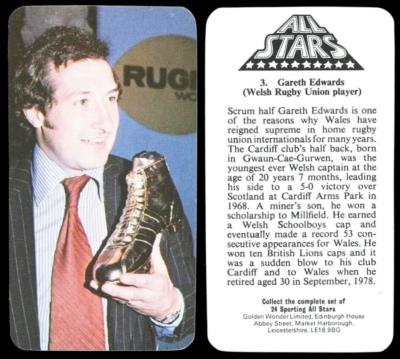
Here we have Gareth [Owen] Edwards, who was born on July 12th, 1947, in Glamorgan, Wales. He was a miner`s son, but became Sir Gareth Owen Edwards CBE MBE, and is still regarded as one of the best rugby union players ever. In fact, in a 2003 poll taken amongst current international players, his name came out top of all. He won three Grand Slams. fifty three caps for Wales, amd in 1997 was one of the first players to be included in the International Rugby Hall of Fame. He also won the first ever "Golden Boot", which he is pictured with on our card. That was awarded at a ceremony at Painter's Hall, in London, on September the 28th,1978.
Now he does not do so well in the card commemoration stakes, and the Trading Card Database lists only eight, two of which are those large double sided thin cards which were designed to go into a fact box.
I can add a few more though
- Tonibell Ice Cream - "Junior Champs" (1983) - square, unnumbered cards.
- Lyons Maid Ice Cream - "Junior Champs" (1983) - as above, except for brand.
- "Great Welsh Rugby Players" (1981) - standard size, issued by The Welsh Rugby Union to mark the centenary of Welsh Rugby Union, 1881-1981, and caricatured by 'Gren', who was the cartoonist for the 'South Wales Echo'. These could possibly be the set of "South Wales Echo Great Welsh Rugby Players which appear at the Trading Card Database without a picture, but those are dated to 1998.
Our set is slightly confusing, because at the top of the reverse it says "All Stars", but at the bottom it says "Sporting All Stars". That is explained in our original British Trade Index part III, which reads :
All Stars Series (A). 68 x 38. Four numbered series. Each card issued in a cellophane envelope. ... GOI-1
1. "Soccer All Stars" (24). [1978]
2. "Sporting All Stars" (24). [1979] Nos. 2, 5, 20 and 22 were originally printed with error series title "Soccer All Stars"; corrected editions have text in larger type-faces than other numbers in the series.
3. "T.V. All Stars" (24). [1979]. Partly without firm`s name, see Fig. GOI-1-3
4. "World Cup Soccer All Stars" (36). [1978].
It is not in our updated version, however, because that only includes pre-1970 cards.
well thats it for another week, curtailed by a very clingy dog who finds my typing a very gross inconvenience whilst he is on my lap trying to fall asleep...
until next week, have fun, and happy collecting from us all
oh and if you missed last weeks newsletter its at
https://csgb.co.uk/publications/newsletter/2021-10-15
